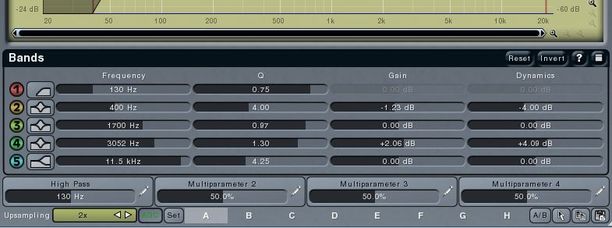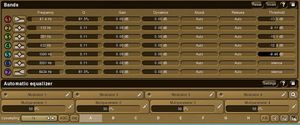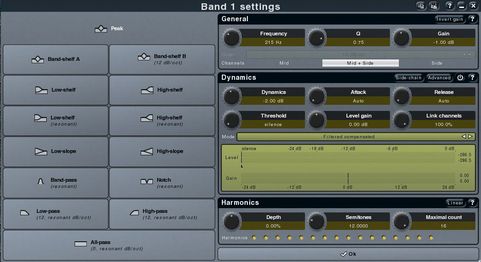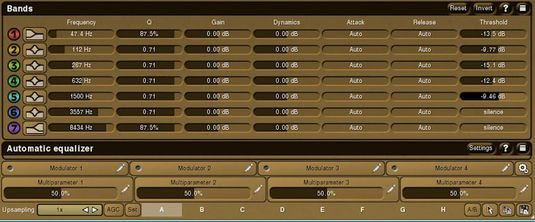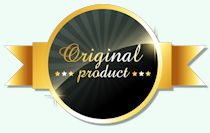|
Visuals - Bands Panel: The lower panel of the main interface is called the “Bands” panel. This is the primary configuration area for each of the five bands, or seven bands, of each Melda MDynamic EQ. By default, each frequency band is adjustable using smooth-responding sliders. These are Frequency, Q, Gain, and Dynamics (gain). The more fully-featured MAutoDynamicEQ includes ‘Attack’, ‘Release’, and ‘Threshold’ controls for immediate, convenient control over the Dynamics properties. If a user just wants to make a fast, approximated change to a band, then it’s easiest to just use mouse click-drag movements up in the “Equalizer Shape Graph”. For more accurate control the user can adjust the sliders down in the “Bands Panel”. For the finest, detailed control, the user needs only to click on any of the sliders while holding down the shift key on his/her computer keyboard. An attractive, easy-to-read virtual numeric pad pops up that allows direct input for keying in precise values. Directly beneath the Bands Panel, there are eight tabs that can be used for storing preset variations. The creative user can even activate a ‘morphing’ mechanism which will cause the plug-in to transition between the saved (loaded) presets. Talk about having an A/B comparison; how about “A” to “H”comparison?! Outstanding Differences – MDynamicEQ or MAutoDynamicEQ? MDynamicEQ: provides five highly-malleable bands of equalization. Any of the five bands can be configured to function in the following 12 band-types: Band-shelf A, Band-shelf B (12dB/octave), Low-shelf, High-shelf, Low-shelf (resonant), High-shelf (resonant), Low-slope, High-slope, Band-pass, Notch, Low-pass (resonant, 12dB/Octave), and finally, High-pass (resonant, 12dB/Octave). The ‘Dynamics’ temperament of each band can be individually manipulated. This is accomplished by clicking on the button located to the far left of each band listed, on the lower panel of the main interface. This will bring up the “Equalizer Band Settings” window. In this window, the user can adjust the full scope of Dynamics and Harmonics characteristics. Both feature-sets are plentiful and grant access to the most common parameters that one would anticipate in a stand-alone compression plug-in and harmonics enhancer. In addition to the five EQ bands, there are two additional frequency bands dedicated to High-pass and Low-pass filtering. These dedicated High/Low pass filters are represented on the “Equalizer Shape Graph” as two thin, vertical red lines. These filters can be set with slopes ranging from 6 dB per octave up to an 'unheard of' 120 dB per octave. This empowers the user with incredible surgical precision over the extreme, opposite ends of the audio spectrum. MAutoDynamicEQ: accords everything that its internship, younger sibling does, plus more direct control over the range of ‘Dynamics’; accessible directly on the main interface. There are two additional equalizer bands. In total, MAutoDynamics furnishes an engineer with nine editable frequency centers, including the High/Low pass filters. A magnificent feature in the even more powerful MAutoDynamicEQ, is its ability to ‘frequency match’. This is inordinately useful for those times when an engineer has to try “nail down” an individual track, or perhaps an entire mix, to have a similar tonality as a reference track. The amount of EQ curve “matching” can be applied by degrees; ranging from 0 to 100 percent. MAutoDynamicEQ derives its name from the powerful ‘automated’ EQ features built into it. This feature tells the plug-in to analyze the incoming audio and automatically configure the bands, based on advanced scientific audio calculations. Don’t believe me? Go ahead and give the downloadable demo a try – it will amaze you. I’m not declaring that the auto function works perfectly in every instance, but it will definitely help you achieve professional, accurate results much faster. There is a library of previously analyzed material, gleaned from famous recordings, from which you can choose to work with as a base reference point. Of course, a user can ‘draw’ his/her own desired curves on the “Shape Graph”. To even out the effect, ensuring that it doesn’t become too pronounced, one need only use the dry/wet ratio slider. The MAutoDynamicEQ auto function is by far the most accurate of any that I have experimented with to date! This is literally, an indispensible, MUST-HAVE tool to be included in any SERIOUS home producer or small studio owner’s musical med bag. I do not recommend this plug-in for anyone who simply likes to ‘collect’ new plug-ins, looking for a quick, magic fix. This is an engineer’s surgical tool – not an expensive “Look what I got” toy. Finally, I’d like to now bring your attention to the four “Modulator” buttons at the bottom of MAutoDynamicEQ’s bottom panel. These allow a user to get creative, and control any parameter (or parameters). These can be used to make “Wah” or auto-Wah effects, and/or dynamic filtering effects that change not only gain, but also frequency according to the input level. Each modulator can be user-assigned to work as an LFO, listen to input level, respond to MIDI commands, make random changes, and even detect input pitch! Very, very cool, Mr. Meluzín. Sound Quality: If MeldaProduction were only known for coming up with cool, innovative ideas, then perhaps their products could simply be dismissed as interesting novelties. However, that is certainly NOT the case. It’s obvious to this reviewer that Vojtěch Meluzín, and the MeldaProduction team, diligently strive to create audio-software that produces exceptional sound quality. It is little wonder that their plug-ins are well-favored by so many professional engineers. Located in the lower right corner you’ll find the “Upsampling” button; perhaps more familiarly known as an oversampling function. When used in its higher quality modes, which can be set in the “Settings” menu, the upsampling is exceptionally clean-sounding and retains upper frequencies very well. *Note that high-quality upsampling mode induces latency, which usually cannot be reported to the host. The dynamic, compression/expansion characteristics of the MDynamic and MAutoDynamic EQs make them perfect choices for subtle, master-mix polishing. Even when ‘pushing’ these EQs with aggressive gain or attenuation, they remain musically smooth and transparent. As an audio engineer myself, I know what it’s like to be disheartened from listening to the results of harsh, sterile digital EQ processing. Sometimes, even the most minor EQ adjustments will sound bad, if you aren’t using a quality processor. The more keen your listening skills become, the more sensitive you will be to harsh or brittle sounds, over compression, loss of dynamics, over-saturation, and etcetera. MDynamic & MAutoDynamic EQs, my dear reader, is just what the doctor ordered. On individual tracks, these EQs still dominate the digital ward with both scientific prowess, and also with elegance and charm. Again, the dynamic nature of these EQs contributes exceptionally smooth, transparent frequency control. Even when making steep, obvious frequency-band modifications, MDynamic & MAutoDynamic EQs remain ‘clean’ and non-destructive. The source signal’s sound and tone will be altered; yes, but the integrity of the audio signal remains intact. Enhanced Effect Control: Remember! MDynamic & MAutoDynamic EQs are NOT intended by the developer to be ‘character’ or ‘coloring’ processors. Nevertheless, given the exceptional quality of MeldaProduction’s Digital Signal Process (DSP) programming, is it any wonder that the “Saturation” feature they've included here is especially good?! The soft-saturation effect ‘warms’ the signal utilizing a carefully calculated code schematic. Melda’s software design accurately mimics the pleasant harmonics saturation attributed to analogue componentry used in old-skool equalizers. The saturation amount is completely adjustable so the user can choose to use as much, or as little, as he/she desires. Side-Chaining: MDynamic & MAutoDynamic EQs are both fully capable of being integrated and used in side-chain operation. I mentioned it earlier in part 1, but the "Bass vs. Bass Drum Fix" preset makes the intimidating task of 'spacing' kick drum/bass guitar a breeze! Stereo Imaging, M/S *and Multi-Channel Processing: Yes, you just read the sub header correctly. These EQs haven’t raised the bar; perhaps they have *become “the bar”. A user is not limited to using these powerful equalizers in only stereo vs. mono modes. There is a selection of eight different channel modes; yes, eight! These are: L+R (Stereo), Left only, Right only, Mid only, Side only, Mid & Side, L+R neg (Right channel inverted), and Surround. The Surround mode will handle up to 8 channels, facilitating 7.1 surround sound EQ processing. In combination with the Analysis and Sonogram screens, the degree of precise mid/side equalization control is immense. I’ve been very blessed to bench-test and review some of the industry’s finest mid/side capable plug-ins; the Melda 7.x plug-ins are most certainly near the very top of my current “BEST-OF” list. The stereo width and imagery of any and all audio material that I processed with these two MeldaProduction ‘Dynamic’ EQs was focused, and remained “seated” in the sonic field; whether stereo, single channel, mono, or mid/side. CPU Consumption: MDynamic & MAutoDynamic EQs can be configured to be very light on CPU. They can also be configured for spectacularly high quality rendering which will cause them to be quite demanding on a system. Perhaps many of my regular reader base is getting tired of hearing about my 6 year old AMD dual core system. Nevertheless, it is very effective for me to use the AMD-powered Toshiba laptop to bench-test and review audio-software. If a plug-in works well on this system, I know that the plug-in will be very easily managed on a more up-to-date computer (Including my own Intel 2nd Gen i3-based audio-production system). Concluding Remarks: MDynamicEQ and it’s even more powerful sibling, MAutoDynamicEQ is an incredibly powerful, cross-platform EQ plug-in that unleashes remarkable Frequency-Equalization control. As potent as these MDynamic EQs are, they can be harnessed easily enough by all engineers, regardless of experience level. MeldaProduction has been a strong, recognizable force of distinction and valour since late 2008. The company have become highly regarded because of their fresh, innovative plug-in developments. Their vast range of specialized, “out-of-the-box” designs may bear similarity to some other products, but Melda is definitely an industry leader – not unoriginal trend “follower”. It is little wonder that famous, industry approved engineers, such as Ian Shepherd, use MeldaProduction software – it is absolutely immense in features, and innovative design. *Ian Shepherd is not involved, nor has ever been involved with Reviewer’s Revival. Mr. Shepherd is a very skilled and talented engineer whom I happen to know uses MeldaProduction software. In particular, MAutoDynamicEQ is absolutely one the most versatile, yet easy-to-use equalizer plug-ins for mixing, mastering, and even sound-creation. Due to their tremendous flexibility and variance of CPU vs. quality settings, MDynamic & MAutoDynamic EQs capably address any and all modern equalizing challenges with excellence and power. :: PROS - BEST-in-CLASS, multi-purpose equalization! - Price vs. Value ratio is incomparable for this degree of scientific audio-software engineering. - Can be configured to be light on system resources. - Excellent oversampling. - Par Excellence Mid/Side and multi-channel processing. - Vast range of highly configurable preferences & options. - Well-designed, Resizable GUI. - Broad selection of customizable color-themes. - Good selection of usable presets. - Smooth GUI parameters. - Immense configurability for all features. - Complete, and well-written documentation. - Large library of video tutorials available on company web site. - Polite, professional product support. - Exceptional reliability. - Regular, consistent updates and improvements – FREE for the life of the product. - No dongles, call/response challenges, nor invasive piracy protection overhead. - Multi-platform MAC & PC & 64 bit. :: CONS - To fit everything on the screen, there are a large number of GUI parameters to be seen at any one time. Unfortunately, the typeface has to be quite small to fit everything in. Visit the MeldaProduction website for these, and other goodies. MeldaProduction.com Brother Charles is a freelance writer, Gospel music artist and minister. Charles had been a professional touring musician during the nineties; working primarily as a lead guitarist in the Canadian country music industry. Brother Charles is also involved with music production and quality home recording.
2 Comments
7/24/2013 02:11:07 pm
Excellent review, thanks. These eq's look awesome!
Reply
Leave a Reply. |
Subscribe to the Reviewer's Revival NewsFlash for notifications of the latest REVIEWS, SALES and exclusive COUPON-CODES. CLICK HERE |

